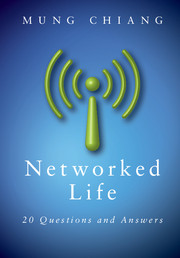Book contents
- Frontmatter
- Contents
- Preface
- Acknowledgements
- Roadmap
- 1 What makes CDMA work for my smartphone?
- 2 How does Google sell ad spaces?
- 3 How does Google rank webpages?
- 4 How does Netflix recommend movies?
- 5 When can I trust an average rating on Amazon?
- 6 Why does Wikipedia even work?
- 7 How do I viralize a YouTube video and tip a Groupon deal?
- 8 How do I influence people on Facebook and Twitter?
- 9 Can I really reach anyone in six steps?
- 10 Does the Internet have an Achilles' heel?
- 11 Why do AT&T and Verizon Wireless charge me $10 a GB?
- 12 How can I pay less for each GB?
- 13 How does traffic get through the Internet?
- 14 Why doesn't the Internet collapse under congestion?
- 15 How can Skype and Bit Torrent be free?
- 16 What's inside the cloud of iCloud?
- 17 IPTV and Netflix: How can the Internet support video?
- 18 Why is WiFi faster at home than at a hotspot?
- 19 Why am I getting only a few % of the advertised 4G speed?
- 20 Is it fair that my neighbor's iPad downloads faster?
- Index
- Notes
8 - How do I influence people on Facebook and Twitter?
Published online by Cambridge University Press: 05 November 2012
- Frontmatter
- Contents
- Preface
- Acknowledgements
- Roadmap
- 1 What makes CDMA work for my smartphone?
- 2 How does Google sell ad spaces?
- 3 How does Google rank webpages?
- 4 How does Netflix recommend movies?
- 5 When can I trust an average rating on Amazon?
- 6 Why does Wikipedia even work?
- 7 How do I viralize a YouTube video and tip a Groupon deal?
- 8 How do I influence people on Facebook and Twitter?
- 9 Can I really reach anyone in six steps?
- 10 Does the Internet have an Achilles' heel?
- 11 Why do AT&T and Verizon Wireless charge me $10 a GB?
- 12 How can I pay less for each GB?
- 13 How does traffic get through the Internet?
- 14 Why doesn't the Internet collapse under congestion?
- 15 How can Skype and Bit Torrent be free?
- 16 What's inside the cloud of iCloud?
- 17 IPTV and Netflix: How can the Internet support video?
- 18 Why is WiFi faster at home than at a hotspot?
- 19 Why am I getting only a few % of the advertised 4G speed?
- 20 Is it fair that my neighbor's iPad downloads faster?
- Index
- Notes
Summary
To study a network, we have to study both its topology (the graph) and its functionalities (tasks carried out on top of the graph). This chapter on topology-dependent influence models does indeed pursue both, as do the next two chapters.
A Short Answer
Started in October 2003 and formally founded in February 2004, Facebook has become the largest social network website, with 900 million users worldwide as of spring 2012 at the time of its IPO. Many links have been formed among these nodes, although it is not straightforward to define how many mutual activities on each other's wall constitute a “link.”
Founded in July 2006, Twitter attracted more than 500 million users in six years. At the end of 2011, over 250 million tweets were handled by Twitter each day. Twitter combines several functionalities into one platform: microblogging (with no more than 140 characters), group texting, and social networking (with one-way following relationships, i.e., directional links).
Facebook and Twitter are two of the most influential communication modes, especially among young people. For example, in summer 2011's east-coast earthquake in the USA, tweets traveled faster than the earthquake itself from Virginia to New York. They have also become a major mechanism in social organization. In summer 2009, Twitter was a significant force in how the Iranians organized themselves against the totalitarian regime.
- Type
- Chapter
- Information
- Networked Life20 Questions and Answers, pp. 158 - 193Publisher: Cambridge University PressPrint publication year: 2012



